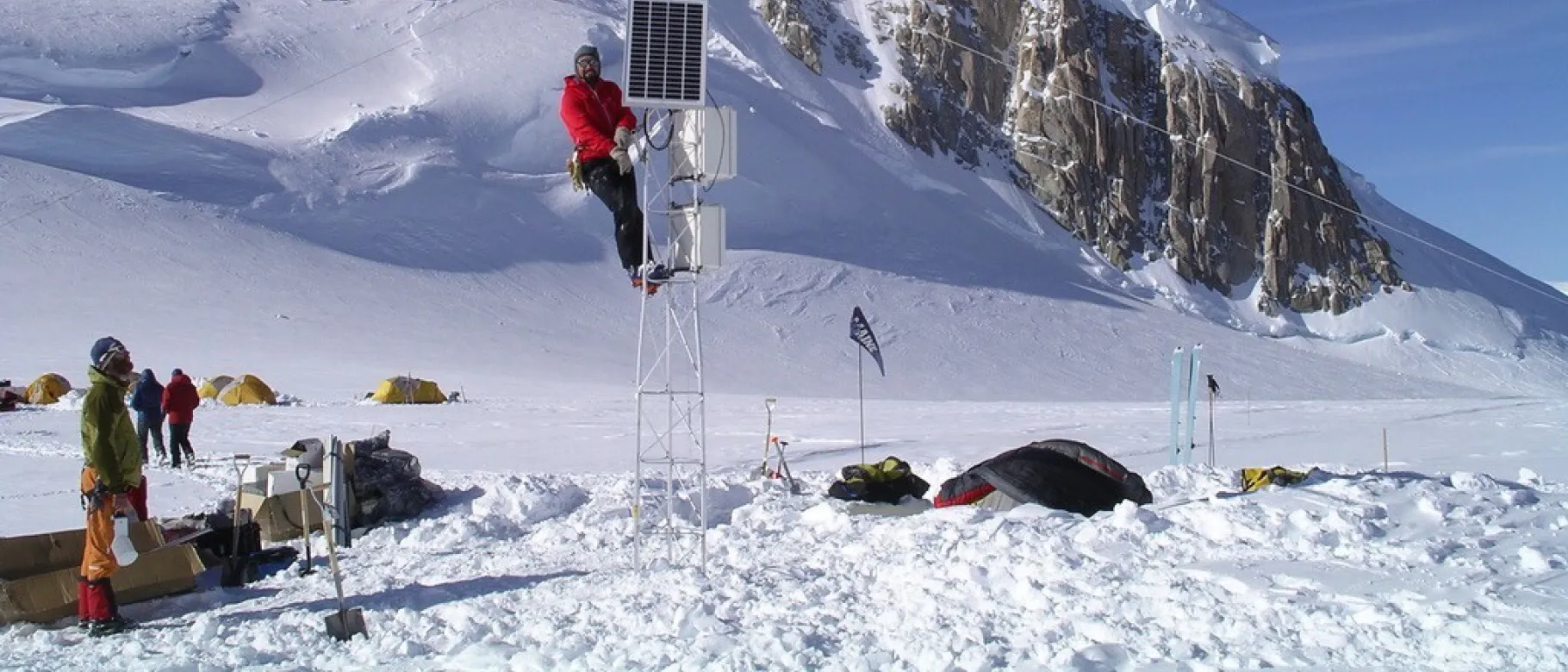UNE’s Cameron Wake and climatologists challenge ocean productivity theory

When Cameron Wake, Ph.D., helped lead a scientific expedition to Denali National Park in Alaska with a team of scientists in 2013, it was to drill ice cores to help better understand hydrological changes of the climate systems in the North Pacific, since few scientists had previously drilled ice cores in the region. Now, new research from the Alaskan ice cores has challenged the prevailing theory that North Atlantic ocean productivity is in decline.
The team of scientists from Dartmouth and the University of Maine who collaborated with Wake, the director of UNE North: Center for North Atlantic Studies at the University of New England, published their paper in Nature Geoscience on Sept. 23 — research that is expected to create a buzz among climatologists.

UNE North Director Cameron Wake
“We chose to focus our efforts on the North Pacific region starting back in the 1990s,” said Wake, who first drilled an ice core in the North Pacific region when he did so in the Yukon Territory in 1996. “The Denali ice core record is the culmination of two decades of research efforts in the region; it is one of the best ice core records we have developed due to the high-resolution record and exact dating.”
Previously, ice core researchers in the Northern Hemisphere had focused on ice cores extracted from Greenland to assess environmental and climatic change due to its location in the North Atlantic, cold temperatures, and vast and deep ice sheets.
Greenland ice core records had pointed to a collapse in North Atlantic marine phytoplankton stocks as evidence for a decline in ocean productivity, because of the decline in the chemical species known as methanesulfonic acid, or MSA, measured in the ice cores, a decline that was interpreted to reflect changes in ocean primary productivity. The two Denali ice cores also showed a decline in MSA at similar levels — but a full 93 years later than the Greenland records.
The Denali team worked with other researchers from partner institutions to unravel the mystery around the timing using atmospheric chemical modeling that pointed to a new interpretation: It’s not climate change that caused the decline in ocean productivity, and therefore a decline of MSA in the ice cores, but, rather the changing oxidation state of the atmosphere due to pollution originating from internal combustion engines that emit nitrogen oxides.
The reason the timing of the MSA decline in the two ice-core records is different, the team of climatologists assert, is because pollution in eastern North America and Europe (the primary source of air masses for Greenland) ramped up during the Industrial Revolution Age in the early 1900s, when the Greenland cores show the decline in MSA levels, while the Denali cores show a shift coming in the 1970s, when the use of fossil fuels began to ramp up in China, located upwind across the Bering Sea from Alaska.
“These data show the power of regulations to reduce air pollution, that they can have an immediate effect once you turn off the spigot,” said Eric Osterberg, associate professor of earth sciences at Dartmouth, who worked on the study with lead author Jacob Ian Chalif, a graduate student in Osterberg’s lab
“I worry about younger people resigning to an environmental crisis because all we hear about is bad news. I think it's important to acknowledge good news when we get it. Here, we see that regulations can work,” Osterberg added.
The team that contributed to the paper titled “Pollution Drives Multidecadal Decline in Subartic Methanesuflonic Acid” included climatologists from Colby College, the University of Washington, the University of Alaska, South Dakota State University, and the Bigelow Laboratory for Ocean Sciences in East Boothbay, Maine.
“We used an atmospheric box model to examine changes in the oxidation state of the atmosphere and we found that the decline in MSA in ice core records from Denali and Greenland can be best explained as reflecting an atmospheric pollution signal,” said Wake, who worked at the University of New Hampshire when the team drilled the two Denali ice cores in 2013 and was a co-leader on the expedition.
When the original scientific expedition set out to obtain ice cores from Denali National Park in 2013, it wasn’t looking to debunk a theory about ocean productivity. The expedition, funded by a $1.1 million National Science Foundation grant, was intended to develop a high-resolution record of climate and environmental change to explore change in the climate systems in the North Pacific. Initial results from ice core analysis showed that snow accumulation doubled over the past 170 years at 13,000 feet above sea level in Denali National Park — home to North America’s highest mountain peak.
The Denali ice cores, which resulted in several other published papers, provided what scientists’ call “a high-fidelity record.” The cores came from a location with well-preserved ice with annual snow accumulation rates of dozens of feet per year. The ice cores also reached all the way to the bedrock.
Wake, a climatologist who led more than 20 scientific research expeditions to the mountains of Central Asia and the Arctic before coming to UNE, said the team’s findings offer a more hopeful perspective that the Earth’s rapidly changing climate has not yet caused a significant decline in ocean productivity in the North Atlantic or North Pacific.
“I think that this is some good news that our ice core MSA records suggest that ocean productivity in the Northern Hemisphere is not in decline,” Wake said. “There are still a lot of problems with climate change, but the new evidence suggests maybe global ocean productivity is not one of them.”
Read press coverage in Newsweek (Sept. 26, 2024).